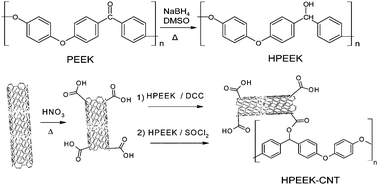Grafting of a hydroxylated poly(ether ether ketone) to the surface of single-walled carbon nanotubes
Abstract
A hydroxylated poly(ether ether ketone) (

* Corresponding authors
a
Department of Physics and Engineering, Institute of Polymer Science and Technology (CSIC), Juan de la Cierva 3, Madrid, Spain
E-mail:
adiez@ictp.csic.es
Fax: +34 91 5644853
Tel: +34 91 5622900
b Institute of Carbon Chemistry (CSIC), Miguel Luesma Castan 4, Zaragoza, Spain
A hydroxylated poly(ether ether ketone) (

 Please wait while we load your content...
Something went wrong. Try again?
Please wait while we load your content...
Something went wrong. Try again?
A. M. Díez-Pascual, G. Martínez, J. M. González-Domínguez, A. Ansón, M. T. Martínez and M. A. Gómez, J. Mater. Chem., 2010, 20, 8285 DOI: 10.1039/C0JM01238F
To request permission to reproduce material from this article, please go to the Copyright Clearance Center request page.
If you are an author contributing to an RSC publication, you do not need to request permission provided correct acknowledgement is given.
If you are the author of this article, you do not need to request permission to reproduce figures and diagrams provided correct acknowledgement is given. If you want to reproduce the whole article in a third-party publication (excluding your thesis/dissertation for which permission is not required) please go to the Copyright Clearance Center request page.
Read more about how to correctly acknowledge RSC content.
 Fetching data from CrossRef.
Fetching data from CrossRef.
This may take some time to load.
Loading related content
